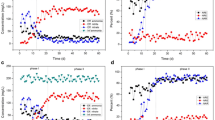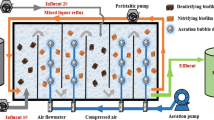Abstract
In this research, a novel packed anoxic/oxic moving bed biofilm reactor (MBBR) was established to achieve high-organic matter removal rates, despite the carbon/nitrogen (C/N) ratio of 2.7–5.1 in the influent. Simultaneous nitrification–denitrification (SND) was investigated under a long sludge retention time of 104 days. The system exhibited excellent performance in pollutant removal, with chemical oxygen demand and total nitrogen (TN) enhanced to 93.6–97.4% and 34.4–60%, respectively. Under low C/N conditions, the nitrogen removal process of A/O MBBR system was mainly achieved by anaerobic denitrification. The increase of C/N ratio enhanced SND rate of the aerobic section, where dissolved oxygen was maintained at the range of 4–6 mg/L, and resulted in higher TN removal efficiency. The microbial composition and structures were analyzed utilizing the MiSeq Illumina sequencing technique. High-throughput pyrosequencing results indicated that the dominant microorganisms were Proteobacteria and Bacteroidetes at the phylum level, which contributes to the removal of organics matters. In the aerobic section, abundances of Nitrospirae (1.12–29.33%), Burkholderiales (2.15–21.38%), and Sphingobacteriales (2.92–11.67%) rose with increasing C/N ratio in the influent, this proved that SND did occur in the aerobic zone. As the C/N ratio of influent increased, the SND phenomenon in the aerobic zone of the system is the main mechanism for greatly improving the removal rate of TN in the aerobic section. The C/N ratio in the aerobic zone is not required to be high to exhibit good TN removal performance. When C/NH4+ and C/TN in the aerobic zone were higher than 2.29 and 1.77, respectively, TN removal efficiency was higher than 60%, which means that carbon sources added to the reactor could be saved. This study would be vital for a better understanding of microbial structures within a packed A/O MBBR and the development of cost-efficient strategies for the treatment of low C/N wastewater.






Similar content being viewed by others

References
Gong L, Li J, Yang Q, Wang S, Ma B, Peng Y (2012) Biomass characteristics and simultaneous nitrification–denitrification under long sludge retention time in an integrated reactor treating rural domestic sewage. Biores Technol 119(9):277–284
Luostarinen S, Luste S, Valentín L, Rintala J (2006) Nitrogen removal from on-site treated anaerobic effluents using intermittently aerated moving bed biofilm reactors at low temperature. Water Res 40(8):1607–1615
Trapani A, Lopedota A, Franco M, Cioffi N, Ieva E, Garcia-Fuentes M, Alonso MJ (2010) A comparative study of chitosan and chitosan/cyclodextrin nanoparticles as potential carriers for the oral delivery of small peptides. Eur J Pharm Biopharm 75(1):26–32
Rusten B, Hem LJ, Ødegaard H (1995) Nitrification of municipal wastewater in moving-bed biofilm reactors. Water Environ Res 67(1):75–86
Yoo H, Ahn KH, Lee HJ, Lee KH, Kwak YJ (1999) Nitrogen removal from synthetic wastewater by simultaneous nitrification and denitrification (SND) via nitrite in an intermittently-aerated reactor. Water Res 33(1):145–154
Leyva-Díaz JC, Martín-Pascual J, Muñío MM, González-López J, Hontoria E, Poyatos JM (2014) Comparative kinetics of hybrid and pure moving bed reactor-membrane bioreactors. Ecol Eng 70(5):227–234
Helness H, Ødegaard H (2001) Biological phosphorus removal in a sequencing batch moving bed biofilm reactor. Water Sci Technol 43(1):233–240
Gieseke A, Arnz P, Amann R, Schramm A (2002) Simultaneous P and N removal in a sequencing batch biofilm reactor: insights from reactor- and microscale investigations. Water Res 36(2):501–509
Jun BH, Miyanaga K, Tanji Y, Unno H (2003) Removal of nitrogenous and carbonaceous substances by a porous carrier–membrane hybrid process for wastewater treatment. Biochem Eng J 14(1):37–44
Zhang X, Song Z, Guo W, Lu Y, Qi L, Wen H, Ngo HH (2017) Behavior of nitrogen removal in an aerobic sponge based moving bed biofilm reactor. Biores Technol 245(1282):1285 (Pt A)
Yuan Q, Wang H, Hang Q, Deng Y, Zheng S (2015) Comparison of the MBBR denitrification carriers for advanced nitrogen removal of wastewater treatment plant effluent. Environ Sci Pollut Res 22(18):13970–13979
Yuan Q, Wang HY, Chu ZS, Hang QY, Liu K, Li CM (2017) Influence of C/N ratio on MBBR denitrification for advanced nitrogen removal of wastewater treatment plant effluent. Desalin Water Treat 66(158):165
Martín-Pascual J, López-López C, Cerdá A, González-López J, Hontoria E, Poyatos JM (2012) Comparative kinetic study of carrier type in a moving bed system applied to organic matter removal in urban wastewater treatment. Water Air Soil Pollut 223(4):1699–1712
Calderón K, Martín-Pascual J, Poyatos JM, Rodelas B, González-Martínez A, González-López J (2012) Comparative analysis of the bacterial diversity in a lab-scale moving bed biofilm reactor (MBBR) applied to treat urban wastewater under different operational conditions. Biores Technol 121(7):119–126
Caporaso JG, Lauber CL, Walters WA, Berglyons D, Huntley J, Fierer N, Owens SM, Betley J, Fraser L, Bauer M (2012) Ultra-high-throughput microbial community analysis on the Illumina HiSeq and MiSeq platforms. ISME J 6(8):1621–1624
Magoč T, Salzberg SL (2011) FLASH: fast length adjustment of short reads to improve genome assemblies. Bioinformatics 27(21):2957–2963
Federation WE, Association APH (2005) Standard methods for the examination of water and wastewater. American Public Health Association (APHA), Washington, DC, USA
Di TD, Di BG, Mannina G, Torregrossa M, Viviani G (2015) Effect of C/N shock variation on the performances of a moving bed membrane bioreactor. Biores Technol 189:250–257
Chuang SH, Ouyang CF, Wang YB (1996) Kinetic competition between phosphorus release and denitrification on sludge under anoxic condition. Water Res 30(12):2961–2968
Yogalakshmi KN, Joseph K (2010) Effect of transient sodium chloride shock loads on the performance of submerged membrane bioreactor. Biores Technol 101(18):7054–7061
Cydzik-Kwiatkowska A, Wojnowska-Baryła I (2011) Nitrifying granules cultivation in a sequencing batch reactor at a low organics-to-total nitrogen ratio in wastewater. Folia Microbiol 56(3):201–208
Cydzik-Kwiatkowska A, Zielińska M (2016) Bacterial communities in full-scale wastewater treatment systems. World J Microbiol Biotechnol 32(4):66
Wan CY, De WH, Diels L, Thoeye C, Liang JB, Huang LN (2011) Biodiversity and population dynamics of microorganisms in a full-scale membrane bioreactor for municipal wastewater treatment. Water Res 45(3):1129–1138
Wang X, Hu M, Xia Y, Wen X, Ding K (2012) Pyrosequencing analysis of bacterial diversity in 14 wastewater treatment systems in china. Appl Environ Microbiol 78(19):7042
Kristi Biswas SJT (2012) Microbial community composition and dynamics of moving bed biofilm reactor systems treating municipal sewage. Appl Environ Microbiol 78(3):855–864
Tao L, Mao YJ, Shi YP, Xie Q (2017) Start-up and bacterial community compositions of partial nitrification in moving bed biofilm reactor. Appl Microbiol Biotechnol 101(6):1–12
Lozupone CA, Micah H, Kelley ST, Rob K (2007) Quantitative and qualitative beta diversity measures lead to different insights into factors that structure microbial communities. Appl Environ Microbiol 73(5):1576–1585
Nguyen HT, Le VQ, Hansen AA, Nielsen JL, Nielsen PH (2011) High diversity and abundance of putative polyphosphate-accumulating Tetrasphaera-related bacteria in activated sludge systems. FEMS Microbiol Ecol 76(2):256–267
Fernándezgómez B, Richter M, Schüler M, Pinhassi J, Acinas SG, González JM, Pedrósalió C (2013) Ecology of marine bacteroidetes: a comparative genomics approach. ISME J 7(5):1026–1037
Hu M, Wang X, Wen X, Xia Y (2012) Microbial community structures in different wastewater treatment plants as revealed by 454-pyrosequencing analysis. Bioresour Technol 117(10):72–79
Manefield M, Griffiths RI, Leigh MB, Fisher R, Whiteley AS (2010) Functional and compositional comparison of two activated sludge communities remediating coking effluent. Environ Microbiol 7(5):715–722
Gabarró J, Ganigué R, Gich F, Ruscalleda M, Balaguer MD, Colprim J (2012) Effect of temperature on AOB activity of a partial nitritation SBR treating landfill leachate with extremely high nitrogen concentration. Bioresour Technol 126(6):283–289
Jiang X, Mingchao MA, Jun LI, Anhuai LU, Zhong Z (2008) Bacterial diversity of active sludge in wastewater treatment plant. Earth Sci Frontiers 15(6):163–168
Peng X, Guo F, Ju F, Zhang T (2014) Shifts in the microbial community, nitrifiers and denitrifiers in the biofilm in a full-scale rotating biological contactor. Environ Sci Technol 48(14):8044–8052
Burrell P, Keller J, Blackall LL (1999) Characterisation of the bacterial consortium involved in nitrite oxidation in activated sludge. Water Sci Technol 39(6):45–52
Acknowledgements
We thank colleagues and students from Fudan University for maintaining the treatment systems during the study period. The authors would like to thank the anonymous reviewers for their constructive and positive comments. This study was financially supported by the National Major Science and Technology Program for Water Pollution Control and Treatment (Grant No. 2017ZX07602-001) and ABA chemical donation.
Author information
Authors and Affiliations
Corresponding authors
Ethics declarations
Conflict of interest
This work does not have any conflict of interest.
Additional information
Publisher's Note
Springer Nature remains neutral with regard to jurisdictional claims in published maps and institutional affiliations.
Rights and permissions
About this article
Cite this article
Ding, S., He, J., Luo, X. et al. Simultaneous nitrogen and carbon removal in a packed A/O reactor: effect of C/N ratio on microbial community structure. Bioprocess Biosyst Eng 43, 1241–1252 (2020). https://doi.org/10.1007/s00449-020-02319-3
Received:
Accepted:
Published:
Issue Date:
DOI: https://doi.org/10.1007/s00449-020-02319-3



